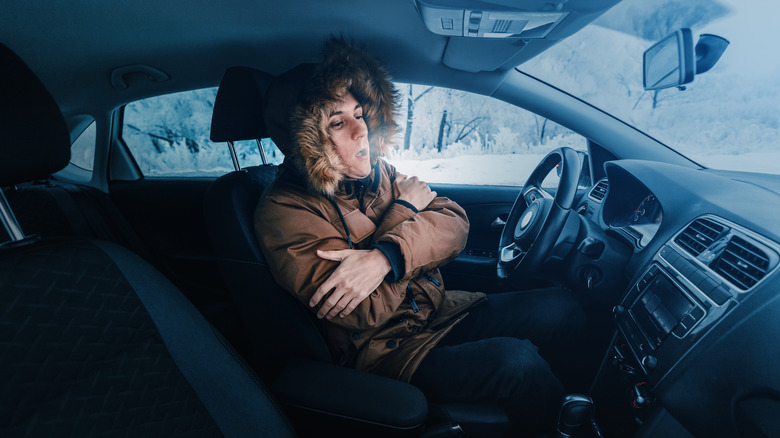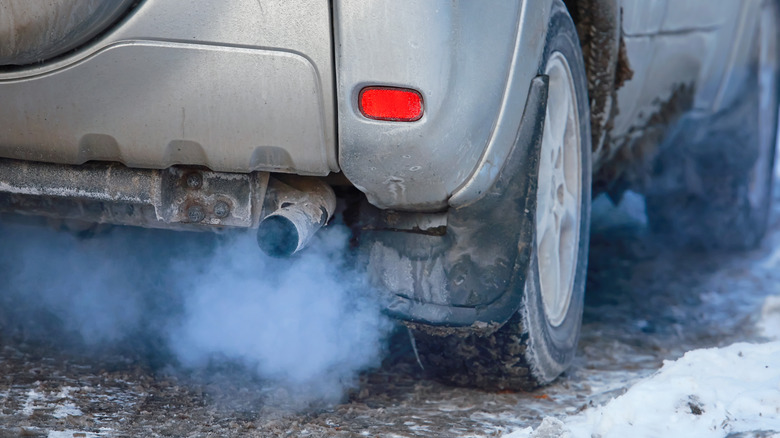How Long Should You Let Your Car Warm Up Before You Drive In The Winter?
Nobody wants to spend more time in the cold than necessary, so it's a good idea for vehicle owners to properly prepare for the colder months of the year. Just as things like snow chains, emergency kits, and ice scrapers need to be on hand and ready to go when needed, people must also alter their schedules to allow sufficient time to warm up the car — or do they?
When winter arrives, some people have been known to leave their cars running for 20 minutes or more after they've been started, while others don't waste any time after they kick the engine into gear, no matter how cold it is outside. There are plenty of ways to overcome the elements, but you may be curious to know how much time should be allotted by motorists to warm up their ride when temperatures are low.
According to John Ibbotson, chief mechanic for Consumer Reports, giving the engine 60 seconds to run on a cold day before putting the car into drive is a wise move. AAA claims after the key is turned, the time it takes to buckle up is all that's needed and that driving at a normal speed will efficiently warm up the engine.
While many people will choose to wait for a toasty ride, a minute is all that is needed to warm up a car in the winter, and consumers should know that doing so for longer is not the greatest idea for several reasons.
Cars shouldn't idle for longer than necessary, even if its chilly
When people rush out to their driveway on a cold morning to get their car properly heated up, drivers should consider some of the downsides to warming up a vehicle longer than necessary.
Idling adds more wear to the engine than turning it on and off in addition to wasting fuel. When a car idles, it uses around 1/5 to 7/10 of a gallon over an hour, which may not seem like much at first. However, slowly warming up the ride every chilly morning will eventually add up and make its presence known in a consumer's gas budget. Ron Zima, founder and CEO of GoGreen Communications, Inc., estimates that people's idling habits, on average, could cost consumers an extra $200 to $1000 a year.
Many people may not realize the effect idling cars have on the environment. The Department of Energy estimates that the approximate 6 billion gallons of fuel wasted from idling each year generates an excess of 58 million tons of CO2 emissions, which isn't helping the current climate crisis. Then there is the health factor to consider because it's no secret that long-term exposure to emissions isn't ideal for anyone, especially kids, adding to the many legitimate and logical reasons people should probably think twice about taking their time to warm up their main source of transportation.
While there are certainly several factors to take into account, there are other easy ways to get the car to the right warm temperature in the winter.
Other ways to heat up inside of car when its cold
If people are convinced that heating the car up for an extended period of time is a bad idea but still don't want to suffer the cold in the process, there are a few options to make taking a ride in the winter months a bit warmer.
There are a number of portable car heaters available that consumers should look into if they want to cut down on their idle behavior. Items to be considered include a wide variety of dashboard heaters, plug-in heated seat warmers, electric blankets, and rechargeable hand warmers, all of which can help make getting into a car on a freezing morning a bit less chilling. Installing a block heater is a great way to heat the engine up faster and warm up the inside of the car as well. And, of course, a travel mug that heats up is another excellent way to keep the cold away while on the go, especially when it's filled with a consumer's favorite warm beverage.
There are, without a doubt, several excellent ways the discomfort of winter car rides can be significantly alleviated without resorting to prolonged idling. So, next time the temperatures drop, remember these innovative solutions and enjoy a warmer, more eco-friendly drive.


